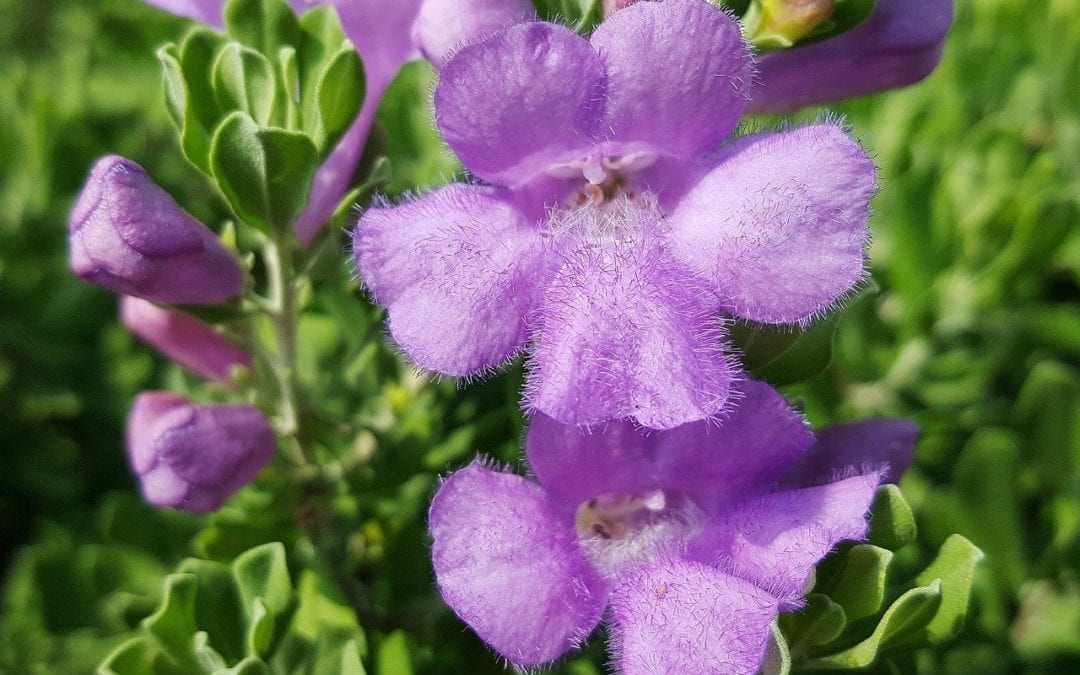Caring for native plants in San Antonio is most definitely less work than if you choose non-native specimens. However, this doesn’t mean that grabbing a native plant, shoving it willy nilly into your landscape, and leaving it to the elements is the route you should be taking. Planning your landscape to include native plants is of the utmost importance in order to be able to enjoy minimal maintenance in the future.
The best way to plan your native landscape is by thoroughly researching plants. Both Rainbow Gardens locations have designated native plant sections as well as many native options dispersed throughout the garden center. Ask to speak to the employee with the most native plant knowledge for help. The Native Plant Society of San Antonio website has a fabulous interactive map so you can find locations where you can see native plants in action. Visit the San Antonio Botanical Gardens display gardens for inspiration. Check out the LadyBird Johnson Wildflower Center website where you can find lists of native plants by state, ecoregion and more. By the time you are ready to plant your landscape, you should know all about the growing requirements, habits, and anything else about any native plant you plan to incorporate.


Another reason to research your plants is so that you can actually see what they will look like at maturity. Native plants sitting in containers and waiting to be purchased have the reputation of turning people off with their slightly scraggly appearance from time to time. They need to get out of those containers and into native soil so that they can reach their full potential! If you know that the future holds giant, pollinator-attracting, sunshine-yellow blooms on that little wispy senna (pictured above) you see at the nursery, you’ll scoop it up knowing you just scored an amazing specimen for your landscape. The deciduous American beautyberry is no longer a pile of twigs when you see its magenta/purple berries lined up and down its branches in an irresistible ombre effect. If you realize that the tiny leaves on the thin branches of a flame acanthus will be massively covered in brilliantly-hued orange/red, tubular flowers that beckon to hummingbirds, you will be less likely to pass it by. A spiky agarita no longer looks menacing when it explodes with colorful berries that feed our native birds. And anyone who has seen the flush of purple blooms on a Texas Sage (title photo) after a rain knows the beauty that native plants can hold. What I’m saying is, when you see native plants at their full potential there is no denying their potential and their draw to our native pollinators.


Researching your native plants also helps you decide where they would fit best in your landscape. You would realize that a horsetail reed (pictured above), or a cardinal flower would be better suited in areas of your landscape that tend to receive or sustain water longer. Or that a quick-draining and dry area might be perfect for a wooly butterfly bush or some cheerful, mounding damianita, both of which don’t care for wet feet. The best thing you can do for any plants, native or non-native, you are thinking of adding to your landscape is to give them the correct environment. So learn your landscape too! Don’t spend years fighting what is already there. If you have a soggy area that you are constantly trying to amend, give in. Opt for boggy/riparian native plants to plants to plant there and call it a day.
Lastly, when it comes to researching and planting your plants, take your time. Who says a landscaping job has to be completed in one day, one week, one month, etc…? Landscapes change. I once planted a small tree and then quickly filled in a garden bed choosing plants that would nestle well under the canopy of a tree. The tree struggled and eventually had to be removed and all of my “shade” plants were now offered full sun. I bet you can guess how that went. Had I waited to see how tree (non-native by the way) adapted I might not have not been out the cost of the bedding shrubs and plants. Try a couple native plants at a time and see how you like them. We’re pretty sure you will fall in love!
~The Happy Gardener, Lisa Mulroy


I liked this article, but it would be helpful since you include so many pictures, if when hovering over the picture or in a caption below the picture, you would add the name of the plant. There are a few I might want to try in my garden.
Thanks for the information!
Never mind my last comment…now when I hover over the picture, I see the name of the plant 🙂
No worries. I try to include the info of the pics somewhere in the blog or link to sources with names for plants to research. Thank you so much for reading our blogs, it is much appreciated!